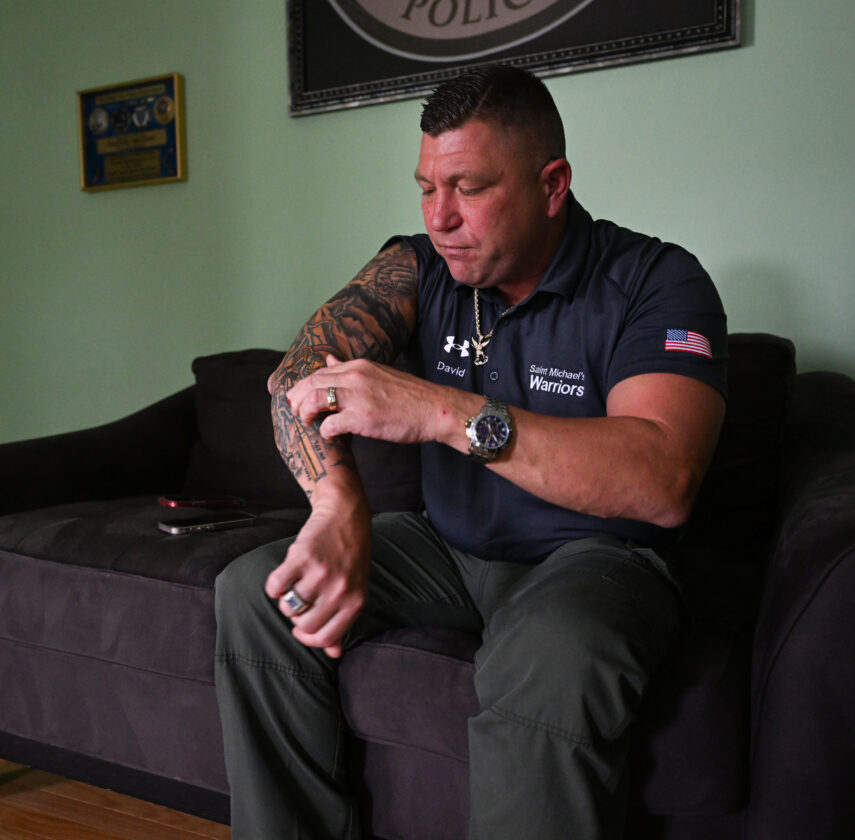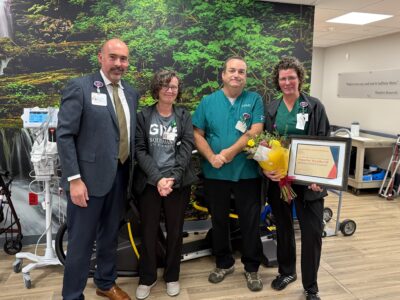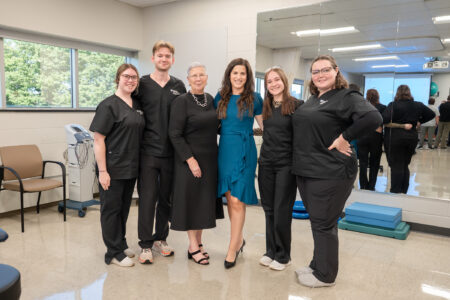Wounded in shooting, former Slatington officer is on a new mission: Destigmatize mental health care for first responders

David Alercia, a former Slatington police officer who was wounded in the line of duty, is seen Monday, Aug. 28, 2023, in his home in Forks Township. Alercia has started St. Michael's Warriors, "an experience-based group created to guide first responders, veterans, active-duty military and their families through difficult times." The group helps those struggling with post-traumatic stress disorder, substance abuse and mental health challenges. (Amy Shortell/The Morning Call)
The bullet didn’t do it, not by itself. What drove David Alercia to heavy drinking, explosions of rage and thoughts of suicide three years ago was a sudden gush of trauma from some mental vault where he had confined it over a quarter-century as a Marine and a police officer.
It began after he was wounded in a shootout and, to a lesser degree, continues today. He doesn’t drink anymore or think about suicide, and if he gets angry, it’s unpleasant but controllable. There is work to be done yet, he knows, but at least the clouds have parted.
This is the result of treatment tailored to who he is and what he does. First responders and veterans encounter horrors most people don’t — bullets and bombs, house fires and car crashes, overdoses, stabbings, shootings — and not every therapy program is tailored to fit that kind of experience.
Such programs exist, however, and Alercia, still idled by disability three years after his crisis, has made it his job to connect people to them through the nonprofit foundation he and his wife, Danielle, launched in July: Saint Michael’s Warriors, named for the archangel who tossed the rebellious Lucifer out of Heaven and has long been the patron of police officers and soldiers.
The impetus for creating the group was the trouble Alercia and his wife had in finding the right places for the right treatment. Queries in the law enforcement community went unanswered or weren’t helpful, and there seemed to be no clearinghouse of information to ease the process. Their trial-and-error search delayed Alercia’s treatment.
“We’re an advocacy center,” Alercia said during a recent interview at his Forks Township home. “We’re going to tell you how to get the help, where to go to get the help. We’re also going to tell you what it’s like when you get that help, what you’re going to experience.”
Beyond that, Alercia said, money raised through the nonprofit will be used to help clients in need with financial demands: transportation to treatment, out-of-pocket medical expenses and day-to-day expenses.
The shootout
The public knows part of Alercia’s story, if not his name. He’s the Slatington police sergeant wounded during a wild exchange of gunfire with a man wanted for shooting at a cigar store clerk after being asked to wear a mask.
This was at the height of the pandemic in 2020, when businesses that were finally allowed to reopen tried to strike a balance between customer service and safety. Police said Adam Zaborowski was having none of it. Rather than comply with the request, he swiped two cigars from the Bethlehem Township store and left, squeezing off two shots from a handgun at the clerk who followed him.
It wasn’t long before police identified Zaborowski, who lived in Slatington. That’s where Alercia entered the story. On Aug. 1, 2020, the day after the robbery, he and several state troopers were staking out the suspect, waiting to serve an arrest warrant. They followed Zaborowski as he left his house in a pickup truck, but rather than pull over, he sped away.
“I knew he knew it was on,” Alercia said, recalling how Zaborowski stopped his truck in the middle of an intersection and came out firing with an AK-47 rifle. Alercia shifted into reverse and sped backward.
What happened next came to define Alercia’s life over the past three years.
He stopped and fired back at Zaborowski through the windshield of the cruiser. The blast from his AR-15 rifle in the closed car was literally deafening, costing Alercia most of the hearing in his left ear.
He had taken a bullet to his right arm, too, near the elbow. It was more than a graze but less than a full-on wound. Alercia didn’t know he’s been shot. He thought glass from the windshield had cut him. He ignored the bleeding, crawled out of his cruiser and made his way around a house to flank Zaborowski.
His intent, drilled into him from his Marine days and his two decades on the job, was to end the threat. In his mind, that meant nothing short of killing the shooter.
He didn’t. He shot Zaborowski in the hip, while state police firing underneath Zaborowski’s truck hit him in the foot. Zaborowski shouted that he wanted to surrender.
While Zaborowski was treated — he was flown to the hospital and survived — Alercia assessed the aftermath. A few people noticed his bleeding but he shrugged it off. “Yeah, it’s just from the glass,” he said.
It took his wife to recognize something more serious had happened. Danielle, who recently retired as a New York City police detective, arrived at the scene after her husband called to tell her what happened. She had worked in the N.Y.P.D.’s Force Investigation Division, which investigates police-involved shootings, and knew a bullet wound when she saw one.
Sure enough, doctors at the hospital pulled bullet fragments out of the wound, which law enforcement officials, discussing the incident with the media, described as minor.
That was true, as far as it went, but it wasn’t the only wound.
Hidden trauma
Alercia is an Easton native. After high school, he served in the Marines for four years and parlayed that training and experience into a job with the Slatington Police Department.
He looks like a Marine-turned-cop — sturdy and muscular, with close-cropped hair. He wears a hearing aid in his left ear, but still leans forward occasionally and cups his hand to that ear when he misses something. His right arm is sleeved with tattoos, one of which marks the scar from the shooting.
When Alercia arrived in Slatington, he found himself in a community no different than any other in the Lehigh Valley in terms of crime. Officers deal with shoplifting, public drunkenness, bar brawls. Sometimes more serious things happen — domestic violence, shootings, stabbings.
One night in 2009, Alercia was first on the scene of a house fire. Armed only with an extinguisher, he pushed his way in and tried to make it up the stairs, where he could hear a woman screaming that she was on fire. Smoke and flames turned him back. Another officer arrived; he couldn’t reach her either. Firefighters pulled the woman out but she died on the way to the hospital.
In retrospect, Alercia said, he probably should have sought help then, because the woman’s screams haunted him at night. But he thought talking things over with his colleague was sufficient.
As Alercia physically recuperated from the shooting, the more serious wounds, the invisible ones, began to manifest. He would drink heavily. He would lose his temper and find himself in a haze of rage, once driving more than 100 mph as he chased someone who cut him off on the highway.
“It was insane,” he said. “It was crazy. I would snap out of it and think, ‘Oh, my God, what am I doing?'”
One characteristic of post-traumatic stress disorder is that it pulls victims back into the trauma. They don’t remember the event; they relive it. Alercia recalled an episode when a rock bounced off his windshield and created a spiderweb crack that made him think a bullet had struck the car and placed his mind squarely back in the shootout.
Alercia also suffered from hypervigilance, a common PTSD symptom. It made him believe danger was imminent at every moment — for himself, his wife, his two sons.
None of this was lost on Danielle, who watched her husband’s decline and became convinced he was struggling with something beyond the mental trauma of the shooting. For one thing, his short-term memory was failing. He’d forget things within minutes.
She proved to be right. When Alercia, after unsuccessful outpatient treatment, finally entered an inpatient program in Florida in June 2021, he had a scan that showed he’d suffered a traumatic brain injury. Doctors said it might have come from the same concussive blast that damaged his left ear when he fired the rifle in his car.
‘The trauma of years’
The Florida program — Hope For Heroes at Transformation Treatment Center in Delray Beach — was Alercia’s first major step in healing. He met other first responders and veterans. He learned the variety of techniques used to combat PTSD — talk therapy, cognitive behavioral therapy, yoga, meditation.
He also attended a five-day retreat in Kansas held by The Battle Within, an organization tailored to helping first responders, veterans and “anyone whose job does not allow them to say no when called upon.”
Through these days of self-examination, he reached surprising conclusions. What most affected him about the shooting, he realized, was not being wounded but failing to kill the suspect, in keeping with the “one shot, one kill” dictum of the Marines.
Anything short of that meant he had failed — the same way he had failed to save the woman from the fire. Hadn’t his own father, a Wilson firefighter, gone into a burning house and rescued three children years ago?
“Dumbass,” his father told him when he shared this regret, “I had gear on. There’s no way you could have gone in there with no gear on.”
It didn’t matter to Alercia. Nor did the commendation he received for stopping the gunman. When he learned Zaborowski had taken his own life in jail, it only underscored what he believed was his own ineptitude — though he acknowledged he would have praised any other cop who put an end to the crisis the same way.
“He had a hard time getting past that idea, that he was a failure,” Danielle said. “I think the shooting was just the catalyst. It was the trauma of years.”
First responders can be especially hurt by falling short of a self-imposed ideal.
“They see it almost as a moral failure,” said Dr. Michael Genovese, an expert in traumatic stress disorders and an advocate for first responders diagnosed with them.
Genovese, the chief medical officer for Acadia Healthcare, a Tennessee behavioral health company, said therapeutic and medical treatments used for first responders are no different than those prescribed for civilians. The difference is that these traditionally hard-nosed professionals often have to be persuaded that it’s all right to accept help.
“What’s really hard is to find doctors and therapists and nurses who understand the law enforcement community and culture, and it’s really important to understand that culture so you can speak to people in terms they will accept,” Genovese said.
For example, first responders, especially police, tend to resist language that hints at any sort of weakness. Cops are the protectors, after all. They provide help, they don’t need it.
Genovese called it a “suck it up, buttercup” culture that frowns on emotional display.
“When I’m speaking to a police officer, I don’t say post-traumatic stress disorder, I just say post-traumatic stress, or post-traumatic injury,” he said. “They can understand injury. If you tell a police officer they have a disorder, that’s the last time they’ll want to talk to you.”
Sometimes, he added, “it takes a law enforcement officer to get a law enforcement officer to open up.”
That’s the thinking behind Saint Michael’s Warriors. Alercia wants people who may be hesitant to seek help to know it’s out there, and that a cop as tough as they come availed himself of it and is healing.
Danielle said the fledgling nonprofit could mean the difference between a rewarding life or a ruined one.
“If we can bring them in and talk to them and fix them from the start, they can go on and have a great career,” she said. “If we can make one person not suffer like David has suffered, it will be worth it.”
If you are struggling with thoughts of suicide or self-harm, call or text 988. The 988 Lifeline provides 24/7, free and confidential support for people in distress.
Saint Michael’s Warriors is online at saintmichaelswarriors.org.
The group will be on hand to provide information during Forks Township Community Days today and Sunday at Forks Community Park, 500 Zucksville Road.




